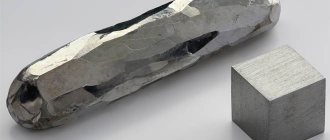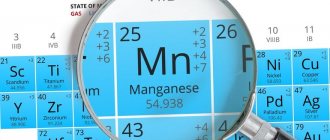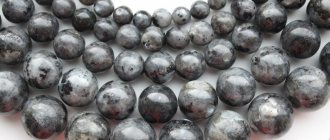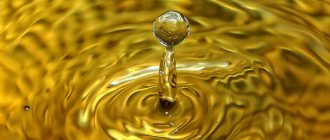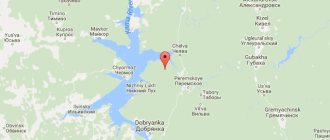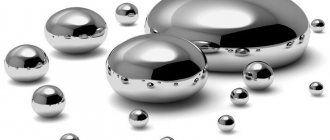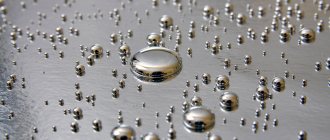History of discovery
One of the main minerals of manganese, pyrolusite, was known in ancient times as black magnesia and was used in glass melting to brighten it. It was considered a type of magnetic iron ore, and the fact that it is not attracted by a magnet was explained by Pliny the Elder by the female gender of black magnesia, to which the magnet is “indifferent.” In 1774, the Swedish chemist K. Scheele showed that the ore contained an unknown metal. He sent samples of the ore to his friend the chemist Yu. Gan, who, by heating pyrolusite with coal in a stove, obtained metallic manganese. At the beginning of the 19th century, the name “manganum” was adopted for it (from the German Manganerz - manganese ore).
Processing of manganese ores
Production depends on the needs of different industries.
Methods for obtaining metal:
- reduction of pyrolusite with silicon, carbon (rarely - aluminum);
- electrolysis of MnSO4 solution; the resulting product is deposited on the cathode;
- pure metallic manganese is obtained by electrolytic method;
- on an industrial scale, manganese is often obtained in the reduction reaction with coal from a mixture of manganese and iron ores.
Prevalence in nature
Manganese is the 14th most abundant element on Earth, and after iron, it is the second heavy metal found in the earth's crust (0.03% of the total number of atoms in the earth's crust). The mass fraction of manganese increases from acidic (600 g/t) to basic rocks (2.2 kg/t). It accompanies iron in many of its ores, but there are also independent deposits of manganese. Up to 40% of manganese ores are concentrated in the Chiatura deposit (Kutaisi region). Manganese dispersed in rocks is washed out by water and carried into the World Ocean. At the same time, its content in sea water is insignificant (10−7–10−6%), and in deep places of the ocean its concentration increases to 0.3% due to oxidation by oxygen dissolved in water with the formation of water-insoluble manganese oxide, which in hydrated form (MnO2 x
H2O) and sinks into the lower layers of the ocean, forming so-called ferromanganese nodules on the bottom, in which the amount of manganese can reach 45% (they also contain impurities of copper, nickel, and cobalt). Such nodules may become a source of manganese for industry in the future.
In Russia it is an acutely scarce raw material; the following deposits are known: “Usinskoye”
in the Kemerovo region,
“Polunochnoe”
in the Sverdlovsk region,
“Porozhinskoye”
in the Krasnoyarsk Territory,
“South-Khinganskoye”
in the Jewish Autonomous Region,
“Rogachevo-Taininskaya” area
and
“North-Taininskoe” field
on Novaya Zemlya.
Manganese minerals
- pyrolusite MnO2 x
H2O, the most common mineral (contains 63.2% manganese); - manganite (brown manganese ore) MnO(OH) (62.5% manganese);
- braunite 3Mn2O3·MnSiO3 (69.5% manganese);
- hausmannite (MnIIMn2III)O4;
- rhodochrosite (manganese spar, crimson spar) MnCO3 (47.8% manganese);
- psilomelane m
MnO MnO2
n
H2O (45-60% manganese); - purpurite Mn3+[PO4], (36.65% manganese).
Extraction methods
Depending on the location and depth of the ore body, the choice of method for extracting manganese ores is made. The geology of the area, as well as economic factors, also have an influence.
Career
The most common method for extracting deposits located near the surface. The pits, which sometimes reach significant sizes, are dug using rotary complexes with a productivity of up to 7000 m3/hour, excavators with a gripping capacity of about 8 m3, and draglines with a bucket volume of 25 m3.
After opening the top layer, produced by excavators with a bucket with a volume of about 5 m3, the rock is removed and crushed. After grinding, the raw materials are loaded onto dump trucks and delivered to processing complexes.
The further fate of the quarry may be different:
- It continues to be developed, capturing new layers.
- They switch to a closed mining method if there are deeper ore bodies.
- Stop exploitation by filling it with earth and carrying out reclamation.
The open pit method is quite productive and is significantly safer compared to the closed mine method.
Shakhtny
However, sometimes it is necessary to extract ore to the surface from the depths of the earth's bowels by digging mines and laying adits. The method is quite expensive and requires special equipment: combines, panel and treatment complexes, conveyors; as well as a significant staff of highly qualified specialists who constantly expose their lives to danger due to harmful effects and possible accidents and disasters.
However, it provides the industry with high-quality ore, does not have a significant impact on the surrounding area and is not affected by weather conditions.
Physical properties
Some properties are shown in the table. Other properties of manganese:
- Electron work function: 4.1 eV
- Coefficient of thermal expansion: 0.000022 K−1 (at 0 °C)
- Electrical conductivity: 0.00695⋅106 Ohm−1 cm−1
- Thermal conductivity: 0.0782 W/(cm K)
- Enthalpy of atomization: 280.3 kJ/mol at 25 °C
- Melting enthalpy: 14.64 kJ/mol
- Enthalpy of vaporization: 219.7 kJ/mol
- Hardness: Brinell scale: Mn/m²
- Mohs scale: 4
Manganese crystal lattice:
| 500 | Crystal cell | |
| 511 | Crystal grid #1 | α-manganese |
| 512 | Lattice structure | Distorted cubic body-centered |
| 513 | Lattice parameters | 8.890 Å |
| 514 | c/a ratio | |
| 515 | Debye temperature | 400 K |
| 516 | Name of space symmetry group | I_ 43m |
| 517 | Symmetry space group number | 217 |
Chemical properties
Standard redox potentials with respect to a hydrogen electrode
| Oxidized form | Restored form | Wednesday | E 0, V |
| Mn2+ | Mn | H+ | −1,186 |
| Mn3+ | Mn2+ | H+ | +1,51 |
| MnO2 | Mn3+ | H+ | +0,95 |
| MnO2 | Mn2+ | H+ | +1,23 |
| MnO2 | Mn(OH)2 | OH− | −0,05 |
| MnO42− | MnO2 | H+ | +2,26 |
| MnO42− | MnO2 | OH− | +0,62 |
| MnO4− | MnO42− | OH− | +0,56 |
| MnO4− | H2MnO4 | H+ | +1,22 |
| MnO4− | MnO2 | H+ | +1,69 |
| MnO4− | MnO2 | OH− | +0,60 |
| MnO4− | Mn2+ | H+ | +1,51 |
Pourbaix diagram for manganese
Characteristic oxidation states of manganese: 0, +2, +3, +4, +6, +7 (oxidation states +1, +5 are uncharacteristic).
Passivates during oxidation in air. Powdered manganese burns in oxygen:
Mn + O2 ⟶ MnO2
When heated, manganese decomposes water, displacing hydrogen:
Mn + 2H2O →∘t Mn(OH)2 + H2↑
In this case, the layer of manganese hydroxide formed slows down the reaction.
Manganese absorbs hydrogen, and with increasing temperature its solubility in manganese increases. At temperatures above 1200 °C it reacts with nitrogen, forming nitrides of various compositions.
Carbon reacts with molten manganese to form carbides Mn3C and others. It also forms silicides, borides, and phosphides.
Reacts with hydrochloric and sulfuric acids according to the equation
Mn + 2H+ ⟶ Mn2+ + H2↑
With concentrated sulfuric acid, the reaction proceeds according to the equation
Mn + 2H2SO4 ⟶ MnSO4 + SO2↑ + 2H2O
With dilute nitric acid, the reaction proceeds according to the equation
3Mn + 8HNO3 ⟶ 3Mn(NO3)2 + 2NO↑ + 4H2O
Manganese is stable in alkaline solution.
Manganese forms the following oxides: MnO, Mn2O3, MnO2, MnO3 (not isolated in the free state) and manganese anhydride Mn2O7.
Mn2O7 under normal conditions is a liquid oily substance of a dark green color, very unstable; when mixed with concentrated sulfuric acid, it ignites organic substances. At 90 °C Mn2O7 decomposes explosively. The most stable oxides are Mn2O3 and MnO2, as well as the combined oxide Mn3O4 (2MnO·MnO2, or salt Mn2MnO4).
When manganese oxide IV (pyrolusite) is fused with alkalis in the presence of oxygen, manganates are formed:
2MnO2 + 4KOH + O2 ⟶ 2K2MnO4 + 2H2O
The manganate solution has a dark green color. When acidified, the reaction occurs
3K2MnO4 + 3H2SO4 ⟶ 3K2SO4 + 2HMnO4 + MnO(OH)2↓ + H2O
The solution turns crimson due to the appearance of the MnO4− anion, and a brown precipitate of manganese (IV) oxide-hydroxide precipitates from it.
Manganese acid is very strong, but unstable, it cannot be concentrated to more than 20%. The acid itself and its salts (permanganates) are strong oxidizing agents. For example, potassium permanganate, depending on the pH of the solution, oxidizes various substances, being reduced to manganese compounds of varying degrees of oxidation. In an acidic environment - to manganese (II) compounds, in a neutral environment - to manganese (IV) compounds, in a strongly alkaline environment - to manganese (VI) compounds.
When heated, permanganates decompose with the release of oxygen (one of the laboratory methods for producing pure oxygen). The reaction proceeds according to the equation (using the example of potassium permanganate)
2KMnO4 →∘t K2MnO4 + MnO2 + O2
Under the influence of strong oxidizing agents, the Mn2+ ion transforms into the MnO4− ion:
2MnSO4 + 5PbO2 + 6HNO3 ⟶ 2HMnO4 + 2PbSO4 + 3Pb(NO3)2 + 2H2O
This reaction is used for the qualitative determination of Mn2+ (see section “Determination by chemical analysis methods”).
When solutions of Mn(II) salts are alkalized, a precipitate of manganese(II) hydroxide precipitates out of them, which quickly turns brown in air as a result of oxidation. For a detailed description of the reaction, see the section “Determination by Chemical Analysis”. In neutral or acidic aqueous solutions, the Mn2+ ion forms a pale pink-colored aqua complex [Mn(H2O)6]2+.
Salts MnCl3, Mn2(SO4)3 are unstable. The hydroxides Mn(OH)2 and Mn(OH)3 are basic in nature, MnO(OH)2 is amphoteric. Manganese (IV) chloride MnCl4 is very unstable, decomposes when heated, which is used to produce chlorine:
MnO2 + 4HCl ⟶ MnCl2 + Cl2↑ + 2H2O
The zero oxidation state of manganese manifests itself in compounds with σ-donor and π-acceptor ligands. Thus, carbonyl of the composition Mn2(CO)10 is known for manganese.
Other manganese compounds with σ-donor and π-acceptor ligands (PF3, NO, N2, P(C5H5)3) are also known.
Usage
The bulk of manganum-containing products goes to the steel industry. It consumes ferromanganese to produce steel and cast iron.
We recommend: COPPER - the foundation of civilization
The use of manganese is justified in the following industries:
- glass;
- pharmaceutical;
- glass;
- electrical engineering;
- paintwork.
Mn(OH₂) is used in the textile industry as a brown dye.
In the production of drying oil, metal compounds are used as a drier.
A large amount of manganese goes to the electrical industry, for the production of dry batteries.
Potassium permanganate (colloquially potassium permanganate) is an antiseptic. Used for gargling, treating burns, washing wounds. As an emetic, it is used internally.
Isotopes
Main article: Isotopes of manganese
Manganese is a monoisotopic element - in nature there is only one stable isotope, 55Mn. All other isotopes of manganese are unstable and radioactive, they are obtained artificially. There are 25 known radioactive isotopes of manganese with mass number A
in the range from 44 to 70. The most stable of them are 53Mn (half-life
T
1/2 = 3.7 million years), 54Mn (
T
1/2 = 312.3 days) and 52Mn (
T
1/2 = 5.591 days ). The predominant decay channel for light manganese isotopes (A < 55) is electron capture (and sometimes competing positron decay) into the corresponding chromium isotopes. For heavy isotopes (A > 55), the main decay channel is β− decay into the corresponding iron isotopes. There are also 7 isomers (metastable excited states) with half-lives of more than 100 ns.
World reserves
Information about the world's reserves of manganese ores is extremely contradictory and sometimes constitutes a commercial secret. Thus, according to the US Geological Survey in 2010 they amounted to 565.5 million tons. According to other sources, the world resources of established deposits in 56 countries are estimated at 21.3 billion tons.
The largest reserves of ores of this mineral are located in Africa - 67.4%. Next come:
- Europe – 16.2%.
- Asia – 7.8%.
- America – 5.6%.
- Australia and Oceania – 3%.
Industrial Applications
Application in metallurgy
Manganese in the form of ferromanganese is used to deoxidize steel during its smelting, that is, to remove oxygen from it. In addition, it binds sulfur, which also improves the properties of steels. The introduction of up to 12-13% Mn into steel (the so-called Hadfield steel), sometimes in combination with other alloying metals, greatly strengthens the steel, making it hard and resistant to wear and impact (the so-called “hardening”). This steel is used for the manufacture of ball mills, earth-moving and stone-crushing machines, armor elements, etc. Up to 20% Mn is added to “mirror cast iron”.
In the 1920s–1940s, the use of manganese made it possible to smelt armor steel. In the early 1950s, a discussion arose in the magazine "Steel" on the possibility of reducing the manganese content in cast iron, and thereby refusing to maintain a certain manganese content in the open-hearth smelting process, in which, together with V.I. Yavoisky and V.I. Baptistmansky was attended by E. I. Zarvin, who, based on production experiments, showed the inexpediency of the existing technology. Later he showed the possibility of conducting the open-hearth process on low-manganese cast iron. With the launch of ZSMK, the development of the processing of low-manganese cast iron in converters began.
An alloy of 83% Cu, 13% Mn and 4% Ni (manganin) has a high electrical resistance that changes little with temperature. Therefore, it is used for the manufacture of rheostats, etc.
Manganese is introduced into bronze and brass.
Application in chemistry
A significant amount of manganese dioxide is consumed in the production of manganese-zinc galvanic cells; MnO2 is used in such cells as an oxidizing agent-depolarizer.
Manganese compounds are also widely used both in fine organic synthesis (MnO2 and KMnO4 as oxidizing agents) and industrial organic synthesis (components of hydrocarbon oxidation catalysts, for example, in the production of terephthalic acid by oxidation of p
-xylene, oxidation of paraffins into higher fatty acids).
Manganese arsenide has a gigantic magnetocaloric effect, which increases under pressure.
Manganese telluride is a promising thermoelectric material (thermo-EMF 500 μV/K).
Production technology
The production methods are standard for most ferrous metals, but ferromanganese is often the final product. It is required by steelmakers because it removes oxygen from the steel during melting.
The industrial production of manganese as a metal is based on three methods:
- Aluminothermic. The metal oxide is reduced. Silicon is also used as a reducing agent.
- Reduction of iron ores . Using coke, ferromanganese with a manganese content of 78% is obtained.
- Electrolysis. The purest product is obtained.
It is also possible to enrich carbonate manganese ore. It is burned or leached using sulfuric acid.
Determination by chemical analysis methods
Manganese belongs to the fifth analytical group of cations.
The specific reactions used in analytical chemistry for the detection of Mn2+ cations are as follows:
1. Caustic alkalis
with manganese (II) salts give a white precipitate of manganese (II) hydroxide:
MnSO4 + 2KOH → Mn(OH)2↓ + K2SO4 Mn2+ + 2OH− → Mn(OH)2↓
The precipitate in air changes color to brown due to oxidation with oxygen air.
Executing the reaction.
To two drops of manganese salt solution add two drops of alkali solution. Observe a change in the color of the precipitate.
2. Hydrogen peroxide
in the presence of alkali, oxidizes manganese (II) salts to a dark brown manganese (IV) compound:
MnSO4 + H2O2 + 2NaOH → MnO(OH)2↓ + Na2SO4 + H2O Mn2+ + H2O2 + 2OH− → MnO(OH)2↓ + H2O
Executing the reaction.
To two drops of manganese salt solution add four drops of alkali solution and two drops of H2O2 solution.
3. Lead dioxide PbO2
in the presence of concentrated nitric acid, when heated, oxidizes Mn2+ to MnO4− with the formation of crimson manganese acid:
2MnSO4 + 5PbO2 + 6HNO3 → 2HMnO4 + 2PbSO4↓ + 3Pb(NO3)2 + 2H2O 2Mn2+ + 5PbO2 + 4H+ → 2MnO4− + 5P b2+ + 2H2O
Eta the reaction gives a negative result in the presence of reducing agents, such as hydrochloric acid and its salts, since they interact with lead dioxide, as well as with the resulting permanganic acid. With large amounts of manganese, this reaction cannot be carried out, since an excess of Mn2+ ions reduces the resulting manganese acid HMnO4 to MnO(OH)2, and instead of a crimson color, a brown precipitate appears. Instead of lead dioxide, other oxidizing agents can be used to oxidize Mn2+ into MnO4−, for example, ammonium persulfate (NH4)2S2O8 in the presence of a catalyst - Ag+ ions or sodium bismuthate NaBiO3:
2MnSO4 + 5NaBiO3 + 16HNO3 → 2HMnO4 + 5Bi(NO3)3 + NaNO3 + 2Na2SO4 + 7H2O
Executing the reaction.
Add a little PbO2 into the test tube with a glass spatula, and then 5 drops of concentrated nitric acid HNO3 and heat the mixture in a boiling water bath. Add 1 drop of manganese sulfate solution MnSO4 to the heated mixture and heat again for 10-15 minutes, shaking the contents of the test tube from time to time. Allow the excess lead dioxide to settle and observe the crimson color of the resulting permanganic acid.
When oxidizing with sodium bismuthate, the reaction is carried out as follows. Place 1-2 drops of manganese (II) sulfate solution and 4 drops of 6 N in a test tube. HNO3, add a few grains of sodium bismuthate and shake. Observe the appearance of a crimson color of the solution.
4. Ammonium sulfide (NH4)2S
precipitates flesh-colored manganese II sulfide from a solution of manganese salts:
MnSO4 + (NH4)2S → MnS↓ + (NH4)2SO4 Mn2+ + S2− → MnS↓
The precipitate is easily dissolved in dilute mineral acids and even in acetic acid.
Executing the reaction.
Place 2 drops of a solution of manganese (II) salt into a test tube and add 2 drops of ammonium sulfide solution.
Biological role and content in living organisms
Manganese is found in the bodies of all plants and animals, although its content is usually very small, on the order of thousandths of a percent, it has a significant effect on life, that is, it is a trace element. Manganese affects growth, blood formation and the function of the sex glands. Beet leaves are especially rich in manganese - up to 0.03%, and large quantities are also found in the bodies of red ants - up to 0.05%. Some bacteria contain up to several percent manganese.
Excessive accumulation of manganese in the body affects, first of all, the functioning of the central nervous system. This manifests itself in fatigue, drowsiness, and deterioration of memory functions. Manganese is a polytropic poison that also affects the lungs, cardiovascular and hepatobiliary systems, causing an allergic and mutagenic effect.
Toxicity
Main article: Manganese poisoning
The toxic dose for humans is 40 mg of manganese per day. The lethal dose for humans has not been determined.
When taken orally, manganese is one of the least toxic microelements. The main signs of manganese poisoning in animals are decreased growth, decreased appetite, impaired iron metabolism, and changes in brain function.
There are no reported cases of manganese poisoning in humans caused by ingestion of foods high in manganese. Human poisoning is mainly observed in cases of chronic inhalation of large quantities of manganese at work. It manifests itself in the form of severe mental disorders, including hyperirritability, hypermotility and hallucinations - “manganese madness”. Subsequently, changes in the extrapyramidal system, similar to Parkinson's disease, develop.
It usually takes several years for the clinical picture of chronic manganese poisoning to develop. It is characterized by a rather slow increase in pathological changes in the body caused by an increased content of manganese in the environment (in particular, the spread of endemic goiter, not associated with iodine deficiency).

